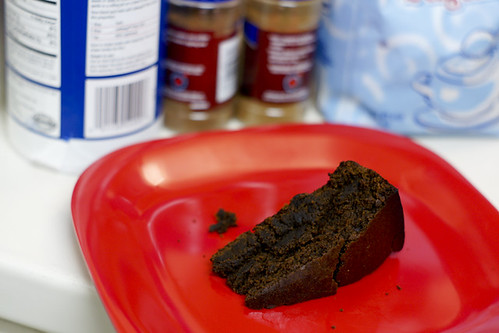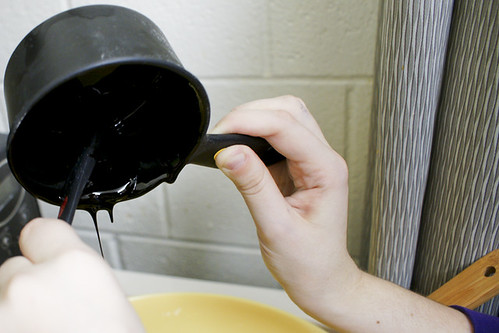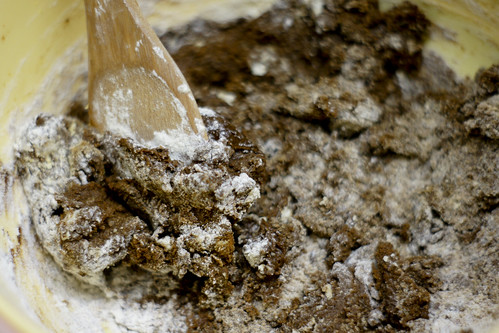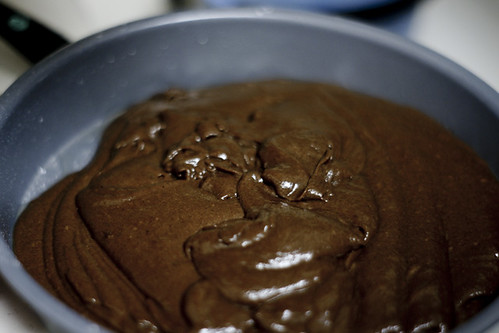
And so the cooking mishaps begin. I wasn't joking when I said I'd blog about my failures as well as my triumphs!
What could be wrong with this perfectly scrumptious-looking cake, you ask? Well, it definitely wasn't the texture - that was spot on. It had a moist, tender crumb and a slightly crunchy surface. Biting into it was wonderful. Tasting it was not. Given, I do have a bit of a cold now, so my nose and therefore taste buds are not working at optimal strength. Still, something was definitely up.

See, I've never had experience with blackstrap molasses. A friend of mine bought it for a recipe she tried earlier in the year, and I knew she still had a bunch of it lying around, so I figured I could use it for my cake as well. Wrong - it completely overwhelmed the other ingredients, so much so that the only flavor was strong and mineral-y. A little research on blackstrap would have behooved me in this case - the words "strong, bitter flavor" might have tipped me off, so that later I wouldn't be biting into this texturally beautiful cake and wondering why it tasted so odd. Research after the fact indicated that blackstrap molasses is indeed used in baked goods but often when mixed with lighter molasses. Since the cake turned out lovely texture-wise, I'm wondering if the recipe wouldn't have failed had I substituted the proper lighter molasses or if the recipe just called for too much in general. Perhaps halving the molasses in the recipe and then subbing other ingredients to make up for it - someone on the original site mentioned corn syrup - would also work. Any thoughts?


However, what made this disappointing experience worth it was - here comes the cliché - the people I had around me. My lovely boyfriend snapping photos of the molasses that would ruin it all, my assistant's confusion over creaming butter and sugar and... well. Let's just say that this cake was made with an audience. An intoxicated audience. I suppose that's what you get for utilizing the dorm kitchen at one in the morning. A few good quotes from the evening:
"What are you baking it in?"
"A round cake pan."
"That's not a loaf!"
"Shaina, seriously. It might be bitter, yes. But honestly, it's still fairly good - better than most of the cakes I've had." - This gent had whipped cream on his nose, as they'd discovered that the sugary cream counteracted the bitterness somewhat.
"I can help you clean up! I'm sober enough to care right now."
The takeaway from this? Drunk people don't care about how their cake tastes, especially not when they're spraying whipped cream

Gingerbread Cake
Adapted from Allrecipes
1/2 cup white sugar
1/2 cup butter
1 egg (note: we divided the egg and first beat the yolks, added it to the sugar and butter mixture, and then beat the egg whites until frothy and folded it into the sugar/butter/egg yolk mixture. As inexperienced bakers, we trust the Internet when it tells us that this contributed to the cake's tenderness.)
1 cup molasses (note: NOT blackstrap, unless you're into its bitterness. Go for something lighter or use less.)
2 1/2 cups all-purpose flour
1 1/2 teaspoons baking soda
3 teaspoons ground cinnamon
2 teaspoons ground ginger
1 teaspoon ground cloves
1/2 teaspoon salt
1 cup hot water
1/4 cup room temperature whole milk (note: the original recipe didn't call for this, but we were hoping for a moister cake)
1. Preheat oven to 350 F. Grease/flour a 9 inch square pan. (note: we used a round, but it turned out fine)
2. In a large bowl, cream together the sugar and butter. Beat in the egg (note: this is where we utilized our egg trick!) and mix in the molasses.
3. In a bowl, sift together the flour, baking soda, salt, cinnamon, ginger and cloves. Blend into the creamed mixture. Stir in the hot water. Add your milk. Pour into the prepared pan.
4. Bake 25-30 minutes until knife inserted in the center comes out clean. Allow to cool in pan before serving (note: we didn't wait. Oops.)
P.S. I left the cake out overnight in the kitchen, hoping that similarly inebriated folk would come by and polish it off for me. Indeed, only about a quarter of the round remained the next morning, and I couldn't help but taste it. Even after being left out in the open air all evening, the texture held! Although the acrid aftertaste remained, the spices were able to fight through the molasses moreso than they had straight out of the oven. Still not my cup of tea, sadly, but it's how you learn, right?

No comments:
Post a Comment